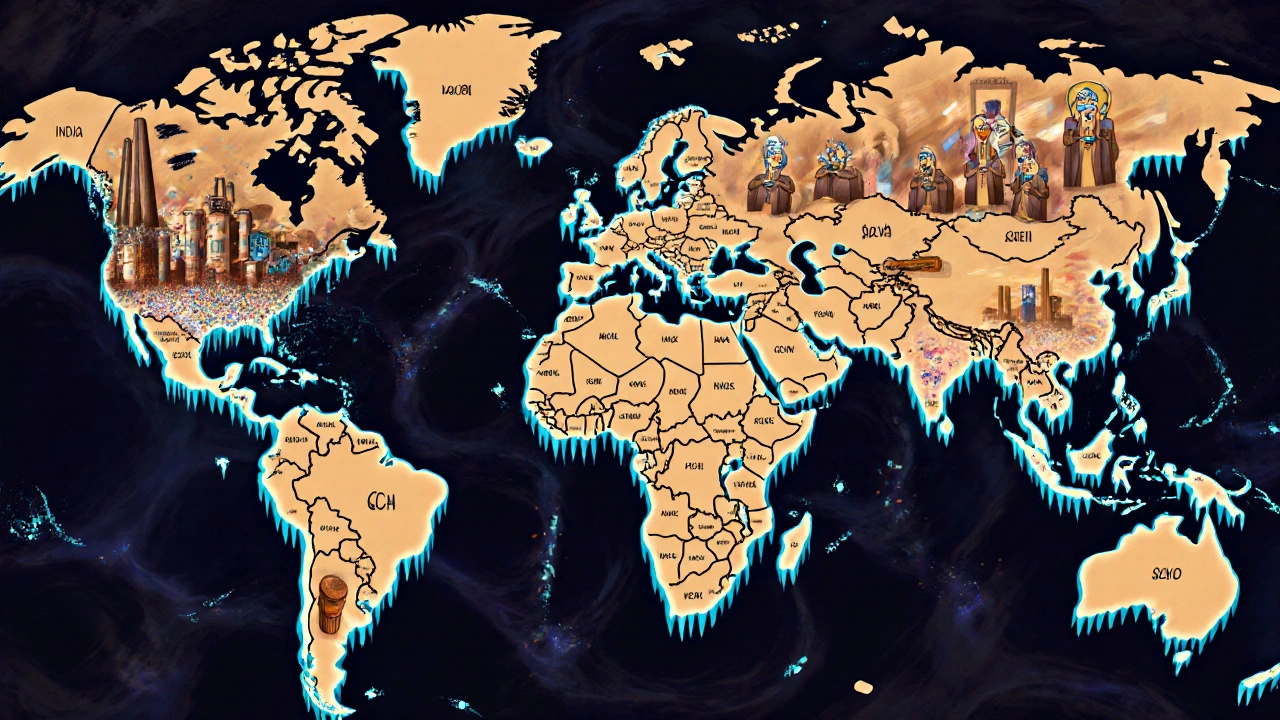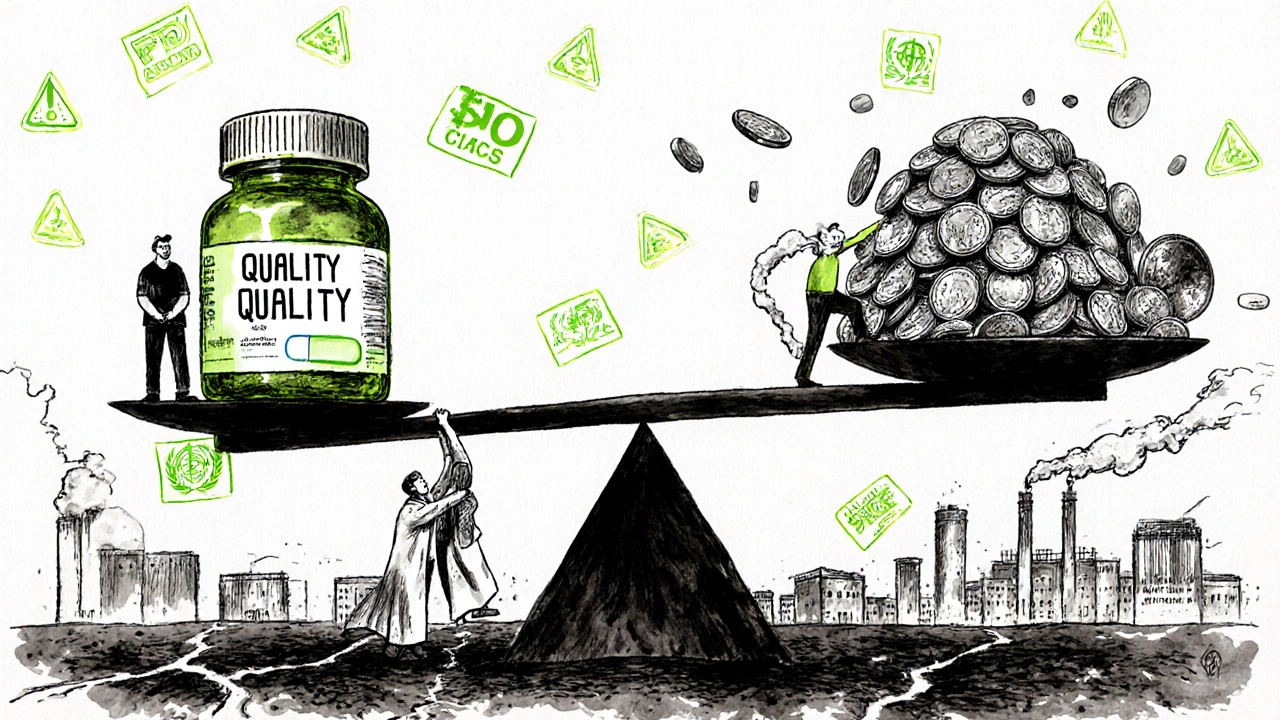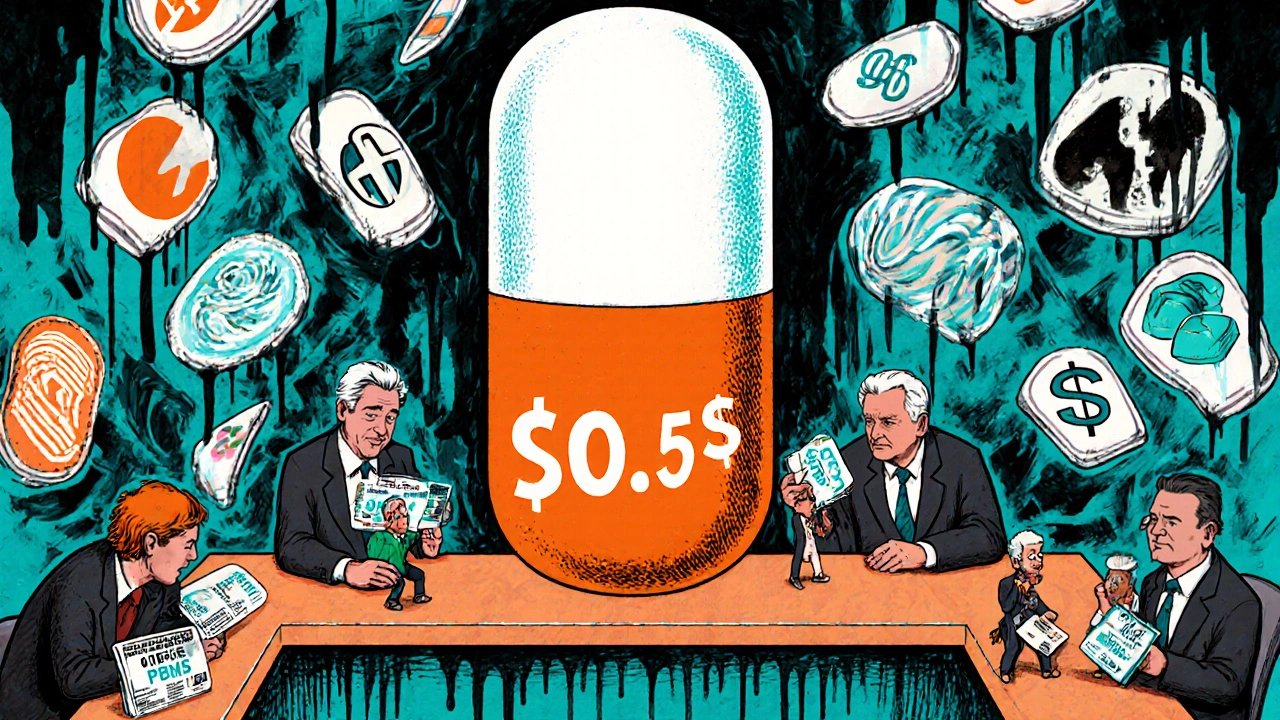By 2025, nearly 90% of all prescriptions filled in the United States are for generic drugs. That’s not just a trend-it’s a system. But how did we get here? And why do the same pills cost five times more in one country than another? The answer isn’t just about science. It’s about policy, politics, and power.
What Exactly Are Generic Drugs, and Why Do They Matter?
Generic drugs are chemically identical to brand-name medications. Same active ingredient. Same dose. Same way they work in your body. The only real difference? Price. Generics cost 80-95% less because they don’t need to repeat expensive clinical trials. Once a patent expires, any qualified manufacturer can make it.
This isn’t a luxury. It’s survival. In the U.S., Medicare saved $142 billion in 2024 just from generics-$2,643 per beneficiary. In the EU, generics make up 65% of prescriptions but only 22% of total drug spending. In India, over 20% of the world’s generic medicines come from a single country. Without them, millions couldn’t afford insulin, blood pressure pills, or antidepressants.
The U.S. Model: High Volume, Low Prices, Big Savings
The U.S. is the world’s biggest market for generics. Why? Three things: strong competition, aggressive pricing, and a well-oiled approval machine.
The FDA’s Orange Book lists over 11,300 approved generics. Companies can file an Abbreviated New Drug Application (ANDA), skipping costly trials. The process usually takes 18-24 months. But if a drug gets designated as a Competitive Generic Therapy (CGT), the timeline drops to 8-12 months. Zenara Pharma’s generic Sertraline, approved in August 2025, is a prime example.
And prices? They’re brutal. The U.S. has the lowest generic prices among wealthy nations. Why? Because there are so many makers-sometimes over 20 for a single drug. That drives competition down to the penny. Medicare and Medicaid negotiate hard. Pharmacy Benefit Managers (PBMs) push for the cheapest option, even if it means switching patients mid-treatment.
But here’s the catch: even with 90.1% generic use, the U.S. still has the highest overall drug prices in the world. Why? Because the branded drugs are astronomically expensive. Generics keep people alive, but they don’t fix the broken system that lets companies charge $1,000 for a single pill of a new cancer drug.
Europe: Harmonized Rules, Fragmented Prices
The European Union has one of the most complex systems. The European Medicines Agency (EMA) approves generics for all 27 member states. Sounds simple, right? Not quite.
Each country sets its own price and decides if it will reimburse the drug. So a generic pill approved in Brussels might cost €0.10 in Germany, €0.40 in Italy, and €0.35 in Poland. The OECD found price differences exceeding 300% for identical products.
Some countries, like Germany, force pharmacists to substitute generics automatically. Others, like Italy, rely on persuasion. The result? A patchwork of access. Patients in one country get affordable meds. In the next, they pay more-or go without.
The EU is trying to fix this. A new Pharmaceutical Package, expected in late 2025, will push for faster generic entry and better price transparency. But progress is slow. National interests always win over European unity.
China: The Price-Cutting Machine
China doesn’t negotiate. It demands.
Since 2018, the country has run Volume-Based Procurement (VBP) auctions. Hospitals bid as a group. Manufacturers compete to offer the lowest price. The winner gets 80% of the hospital’s demand for that drug.
The results? Jaw-dropping. Average price cuts hit 54.7%. Some drugs, like certain antibiotics, dropped 93%. Amlodipine, a common blood pressure pill, went from $1.20 per pill to $0.08.
But there’s a dark side. Manufacturers are bleeding money. A 2025 survey found 23% of generic makers operating at a loss on VBP contracts. Some stopped producing. In 2024, 12 Chinese provinces ran out of Amlodipine for six to eight weeks. Patients panicked. Hospitals scrambled.
China’s system works for affordability-but not for reliability. When margins are razor-thin, quality control slips. The FDA issued 2,183 import alerts for Indian and Chinese generic manufacturers in 2024, up from 1,247 in 2020. Data integrity issues. Contaminated batches. Poor lab practices. The system saves money-but at what cost?

India: The Pharmacy of the World
India makes 20% of the world’s generic drugs by volume. It’s the backbone of global access. But India’s success isn’t just about manufacturing-it’s about law.
Under Section 84 of its Patents Act, India can issue compulsory licenses. If a drug is too expensive or not available, the government can let a local company make it without the patent holder’s permission. This is how India became the main supplier of HIV meds to Africa and low-cost hepatitis C cures to the world.
But it’s not all smooth. Indian generics face constant legal battles with big pharma. The FDA has flagged over 100 Indian plants for quality violations since 2020. Doctors in rural clinics report inconsistent results with certain generics-especially for epilepsy and blood thinners.
Still, for millions in low-income countries, India is the only reason they can afford treatment. Without it, global health equity would collapse.
South Korea: The Tightrope Walk
South Korea tried something radical: limit competition to improve quality.
In 2020, it launched the “1+3 Bioequivalence Policy.” Only the first generic and three others with proven bioequivalence data could enter the market. The goal? Stop the flood of low-quality, identical products that confused doctors and patients.
It worked. Redundant entries dropped by 41%. But it also cut new generic launches by 29%. Fewer competitors meant less pressure to lower prices.
Then came the Differential Pricing System. Generics are now priced in tiers:
- 53.55% of brand price-meets both quality and cost standards
- 45.52%-meets one
- 38.69%-meets neither
This rewards quality. But it also punishes small manufacturers who can’t afford the testing. The result? A more stable market-but less innovation. Experts warn this could delay future generics from entering.
Japan: The Silent Price Cuts
Japan doesn’t have a big generic market-yet. Only 76.8% of prescriptions are filled with generics. But here’s the twist: Japan cuts prices every two years-for everything, branded and generic alike.
These mandatory cuts are brutal. A drug might lose 30% of its price overnight. Manufacturers can’t plan. R&D budgets shrink. New generic launches flatline.
Japan’s system is efficient. But it’s also stagnant. No one’s getting rich. No one’s investing. The market stays small. It’s a trade-off: affordability today, innovation tomorrow.

The Hidden Costs: Quality, Shortages, and Trust
Generics aren’t perfect. And the push for lower prices is starting to crack the foundation.
Patients in the U.S. report 78% satisfaction with generics-but 63% hate how PBMs flip them between brands mid-prescription. In Europe, 44% worry about quality, especially for drugs with narrow therapeutic windows-like warfarin or lithium. One milligram too much, and you bleed. One too little, and you clot.
In India, 58% of doctors say local generics vary in bioavailability. In China, 37% of patients faced shortages during VBP transitions. The WHO warns that if manufacturers can’t make a 15-20% profit margin, they’ll cut corners-or quit.
And the FDA is watching. Import alerts for generic manufacturers have doubled since 2020. Quality isn’t just a technical issue. It’s a public health crisis waiting to happen.
What’s Next? The Big Shifts Coming by 2030
Between 2025 and 2030, $217-236 billion in branded drug sales will lose patent protection. That’s the biggest wave of generic entry in history.
The U.S. Inflation Reduction Act will force Medicare to negotiate prices on 10-20 high-cost drugs by 2028. That could push even more patients toward generics.
China’s VBP will expand to 150 more drugs in January 2026-with prices 65% below current levels. India is speeding up approvals, cutting approval times from 36 months to 14.
But the real question is: can the system handle it?
McKinsey predicts the number of global generic manufacturers will drop from 3,500 to 2,200 by 2030. Only the big players with integrated supply chains will survive. The rest? They’ll be squeezed out.
And if quality drops? If shortages become common? If patients lose trust? Then the whole system collapses.
The Bottom Line: Affordability Without Sacrifice
There’s no perfect system. The U.S. gets volume and savings but keeps branded prices high. China cuts prices to the bone and risks shortages. India supplies the world but struggles with consistency. Europe has the rules but not the unity.
The best models-like South Korea’s tiered pricing or the U.S.’s CGT fast-track-show that smart policy can balance access, quality, and sustainability.
But the biggest threat isn’t lack of generics. It’s the race to the bottom. When every dollar saved means one less quality check, one fewer audit, one more shortage-we’re not saving money. We’re gambling with lives.
The goal shouldn’t be the cheapest pill. It should be the reliable, safe, always-available pill. And that’s not just a policy challenge. It’s a moral one.
Are generic drugs as effective as brand-name drugs?
Yes. By law, generic drugs must contain the same active ingredient, strength, dosage form, and route of administration as the brand-name version. They must also meet strict bioequivalence standards-meaning they deliver the same amount of medicine into your bloodstream at the same rate. The FDA and EMA require generics to be within 80-125% of the brand’s absorption levels. Millions of patients use generics safely every day. Studies consistently show no difference in clinical outcomes between generics and brands.
Why do some people say generics don’t work as well?
Some patients notice differences in pill size, color, or inactive ingredients (like fillers or dyes), which can cause minor side effects like stomach upset. For drugs with a narrow therapeutic index-like warfarin, lithium, or seizure meds-even small changes in absorption can matter. In rare cases, especially in countries with weak regulation, low-quality generics may not meet bioequivalence standards. But in regulated markets like the U.S., EU, Canada, or Australia, these cases are extremely rare. If you feel a difference, talk to your doctor or pharmacist. Don’t assume it’s the generic-it might just be a formulation change.
Why are generic prices so different between countries?
It’s all about policy. Countries use different tools: price controls, bulk purchasing, reference pricing (comparing to other nations), or mandatory substitution. The Netherlands picks non-EU countries as price references to drive prices down. China forces manufacturers to bid for hospital contracts. The U.S. lets competition drive prices to near-zero. In countries with no price controls, manufacturers charge what the market will bear. That’s why the same pill can cost $0.05 in India and $2.50 in the U.S.-even though both are made in the same factory.
Do generic drugs cause more side effects?
No. The active ingredient-the part that treats your condition-is identical. Side effects come from that ingredient, not from the fillers or coatings. However, some people are sensitive to inactive ingredients (like lactose or dyes), and these can vary between brands and generics. If you have allergies or sensitivities, ask your pharmacist to check the label. But in general, the risk of side effects from generics is no higher than from brand-name drugs.
Why don’t all countries use generics more?
It’s not about availability-it’s about policy and culture. In some countries, doctors and patients distrust generics due to past quality issues or misinformation. Others have laws that require doctors to prescribe by brand name. Some governments protect domestic branded drug makers with subsidies or delays in generic approval. In Japan, mandatory price cuts every two years discourage manufacturers from launching new generics. In parts of Africa and Latin America, supply chains are too weak to reliably distribute generics. Changing that takes time, education, and political will.
Will generic drugs still be available in 10 years?
Yes-but maybe not from the same companies. As price pressure grows, smaller manufacturers are being pushed out. Only those with large-scale production, strong quality control, and global supply chains will survive. The WHO warns that if prices fall below manufacturing cost, factories will shut down, leading to shortages. The future of generics depends on finding a balance: prices low enough for patients, but high enough to keep factories open and quality standards intact.

